Deck 15: General Equilibrium
Question
Question
Question
Question
Question
Question
Question
Question
Question
Question
Question
Question
Question
Question
Question
Question
Question
Question
Question
Question
Question
Question
Question
Question
Question
Question
Question
Question
Question
Question
Question
Question
Question
Question
Question
Question
Question
Question
Question
Question
Question
Question
Question
Question
Question
Question
Question
Question
Question
Question
Question
Question
Question
Question
Question
Question
Question
Question
Question
Question
Question
Question
Question
Question
Question
Question
Question
Question
Question
Question
Question
Question
Question
Question
Question
Question
Question
Question
Question
Question

Unlock Deck
Sign up to unlock the cards in this deck!
Unlock Deck
Unlock Deck
1/97
Play
Full screen (f)
Deck 15: General Equilibrium
1
Which of the following statements is (are) TRUE?
I) The Rawlsian social welfare function computes society's welfare by calculating the difference in utility between the top 10% and bottom 10% of income earners.
II) Economists strictly use the Rawlsian social welfare function to evaluate market performance.
III) The Rawlsian utility function only considers the utility of the least well-off person.
A) II and III
B) I, II, and III
C) II
D) III
I) The Rawlsian social welfare function computes society's welfare by calculating the difference in utility between the top 10% and bottom 10% of income earners.
II) Economists strictly use the Rawlsian social welfare function to evaluate market performance.
III) The Rawlsian utility function only considers the utility of the least well-off person.
A) II and III
B) I, II, and III
C) II
D) III
D
2
(Figure: Cereal and Pancakes III) Which of the following statements is (are) TRUE?  I. Pareto efficiency occurs when Elaina consumes 4 pancakes and 3 bowls of cereal and Jose consumes 4 pancakes and 7 bowls of cereal.
I. Pareto efficiency occurs when Elaina consumes 4 pancakes and 3 bowls of cereal and Jose consumes 4 pancakes and 7 bowls of cereal.
II) Pareto efficiency occurs when Elaina consumes 3 pancakes and 3 bowls of cereal and Jose consumes 5 pancakes and 3 bowls of cereal.
III) Pareto efficiency occurs when Elaina consumes 3 pancakes and 3 bowls of cereal and Jose consumes 5 pancakes and 7 bowls of cereal.
A) I
B) I and II
C) II
D) I, II, and III
 I. Pareto efficiency occurs when Elaina consumes 4 pancakes and 3 bowls of cereal and Jose consumes 4 pancakes and 7 bowls of cereal.
I. Pareto efficiency occurs when Elaina consumes 4 pancakes and 3 bowls of cereal and Jose consumes 4 pancakes and 7 bowls of cereal.II) Pareto efficiency occurs when Elaina consumes 3 pancakes and 3 bowls of cereal and Jose consumes 5 pancakes and 3 bowls of cereal.
III) Pareto efficiency occurs when Elaina consumes 3 pancakes and 3 bowls of cereal and Jose consumes 5 pancakes and 7 bowls of cereal.
A) I
B) I and II
C) II
D) I, II, and III
A
3
Sven, Art, and Isabel reside on a tiny island in the Pacific. All three of them have a utility function given by U = Y0.5, where Y is income per day. Suppose that Sven earns $7 per day, Art earns $25 per day, and Isabel earns $36 per day. What happens to the value of the utilitarian social welfare function If the government takes $9 of Art's income and gives it to Sven?
A) The utilitarian social welfare function will increase from 13.65 to 14.
B) The utilitarian social welfare function will remain unchanged at 68.
C) The utilitarian social welfare function will decrease from 15.50 to 12.30.
D) The utilitarian social welfare function will increase from 8.20 to 12.
A) The utilitarian social welfare function will increase from 13.65 to 14.
B) The utilitarian social welfare function will remain unchanged at 68.
C) The utilitarian social welfare function will decrease from 15.50 to 12.30.
D) The utilitarian social welfare function will increase from 8.20 to 12.
A
4
The market for soybeans is characterized by  = 16 - Ps + Pc and
= 16 - Ps + Pc and 
= Ps, where Qs is the quantity of soybeans in millions of bushels, Ps is the price per bushel of soybeans, and Pc is the price per bushel of corn. The market for corn is characterized by
= 40 - Pc + Ps and
= Pc, where Qc is the quantity of corn in millions of bushels. In general equilibrium, what is the equilibrium quantity of soybeans?
A) 42 million bushels
B) 18 million bushels
C) 24 million bushels
D) 30 million bushels
 = 16 - Ps + Pc and
= 16 - Ps + Pc and 
= Ps, where Qs is the quantity of soybeans in millions of bushels, Ps is the price per bushel of soybeans, and Pc is the price per bushel of corn. The market for corn is characterized by

= 40 - Pc + Ps and

= Pc, where Qc is the quantity of corn in millions of bushels. In general equilibrium, what is the equilibrium quantity of soybeans?
A) 42 million bushels
B) 18 million bushels
C) 24 million bushels
D) 30 million bushels

Unlock Deck
Unlock for access to all 97 flashcards in this deck.
Unlock Deck
k this deck
5
The market for coffee is characterized by  and
and 
, where QC is the quantity of coffee in hundreds of pounds, PC is the price per hundred pounds of coffee, and PT is the price per hundred pounds of tea. The market for tea is characterized by
And
, where QT is the quantity of tea in hundreds of pounds. Suppose a new medical study touts the benefits of drinking coffee, leading to an increase of 30 pounds of coffee at every price. The new equilibrium price of tea is ____.
A) $85.72
B) $87.25
C) $94.29
D) $99.42
 and
and 
, where QC is the quantity of coffee in hundreds of pounds, PC is the price per hundred pounds of coffee, and PT is the price per hundred pounds of tea. The market for tea is characterized by

And

, where QT is the quantity of tea in hundreds of pounds. Suppose a new medical study touts the benefits of drinking coffee, leading to an increase of 30 pounds of coffee at every price. The new equilibrium price of tea is ____.
A) $85.72
B) $87.25
C) $94.29
D) $99.42

Unlock Deck
Unlock for access to all 97 flashcards in this deck.
Unlock Deck
k this deck
6
If the initial allocation of goods is not efficient, consumers will:
A) not be able to trade goods and achieve Pareto efficiency.
B) buy and sell goods at market prices until the marginal rate of substitution is equalized across all consumers.
C) be required to consume somewhere along their contract curve.
D)
A) not be able to trade goods and achieve Pareto efficiency.
B) buy and sell goods at market prices until the marginal rate of substitution is equalized across all consumers.
C) be required to consume somewhere along their contract curve.
D)

Unlock Deck
Unlock for access to all 97 flashcards in this deck.
Unlock Deck
k this deck
7
Maximilian rules over a three-person society. The three people are Andre, Bojan, and Soumendra. Andre has a utility level of 60, Bojan's utility level is 80, and Soumendra's utility level is 10. In this society, assuming resources and utility can be transferred among the people, the highest value that the Rawlsian social welfare function can obtain is ____.
A) 10
B) 30
C) 50
D) 150
A) 10
B) 30
C) 50
D) 150

Unlock Deck
Unlock for access to all 97 flashcards in this deck.
Unlock Deck
k this deck
8
Which of the following is an example of partial equilibrium analysis?
A) A tax on Internet sales reduces the quantity of online sales and the demand for Internet access. The lower price for Internet access will spur increased demand for online sales.
B) A deep freeze has destroyed much of the orange crop, raised the price of oranges, and reduced the quantity sold.
C) Productivity enhancements in the manufacturing sector have increased wages in that sector, putting upward pressures on wages necessary to attract workers to the service sector.
D) Scientific research indicates that there are health benefits to wearing cotton. Knowledge of these benefits raises the demand for cotton and reduces the supply of corn as farmers plant more cotton.
A) A tax on Internet sales reduces the quantity of online sales and the demand for Internet access. The lower price for Internet access will spur increased demand for online sales.
B) A deep freeze has destroyed much of the orange crop, raised the price of oranges, and reduced the quantity sold.
C) Productivity enhancements in the manufacturing sector have increased wages in that sector, putting upward pressures on wages necessary to attract workers to the service sector.
D) Scientific research indicates that there are health benefits to wearing cotton. Knowledge of these benefits raises the demand for cotton and reduces the supply of corn as farmers plant more cotton.

Unlock Deck
Unlock for access to all 97 flashcards in this deck.
Unlock Deck
k this deck
9
Farmers can use their land to grow corn or cotton. Because of the increased demand for moisture-wicking sportswear, the demand for cotton has decreased. What are the general equilibrium effects in the markets for corn and for cotton?
A) The price of cotton will fall because of the decrease in demand, and farmers will plant less cotton. The decrease in the supply of cotton will raise both cotton prices and the demand for corn.
B) The price of cotton will fall because of the decrease in demand, and farmers will plant less cotton and more corn. The increase in the supply of corn will push down corn prices.
C) The price of cotton will fall because of the decrease in demand, and farmers will plant less corn. The decrease in the supply of corn will raise corn prices and depress the demand for cotton.
D) The price of cotton will rise because of the decrease in demand, and farmers will plant more cotton and less corn. The decrease in the supply of corn will push up corn prices.
A) The price of cotton will fall because of the decrease in demand, and farmers will plant less cotton. The decrease in the supply of cotton will raise both cotton prices and the demand for corn.
B) The price of cotton will fall because of the decrease in demand, and farmers will plant less cotton and more corn. The increase in the supply of corn will push down corn prices.
C) The price of cotton will fall because of the decrease in demand, and farmers will plant less corn. The decrease in the supply of corn will raise corn prices and depress the demand for cotton.
D) The price of cotton will rise because of the decrease in demand, and farmers will plant more cotton and less corn. The decrease in the supply of corn will push up corn prices.

Unlock Deck
Unlock for access to all 97 flashcards in this deck.
Unlock Deck
k this deck
10
The New Democratic Party in Canada is concerned that the Canadian oil boom has increased the exchange rate, thereby harming the manufacturing sector by making it less competitive in international markets. This concern highlights the notion of _____ and can best be studied by using _____ analysis.
A) Dutch disease; general equilibrium
B) Dutch disease; partial equilibrium
C) Baumol's cost disease; general equilibrium
D) Baumol's cost disease; partial equilibrium
A) Dutch disease; general equilibrium
B) Dutch disease; partial equilibrium
C) Baumol's cost disease; general equilibrium
D) Baumol's cost disease; partial equilibrium

Unlock Deck
Unlock for access to all 97 flashcards in this deck.
Unlock Deck
k this deck
11
(Figure: Pancakes and Cereal I) At point G, the marginal cost of a pancake is 50 cents and the marginal cost of a bowl of cereal is also fifty cents. At this point, consumers are willing to trade 2 bowls of cereal for an additional pancake. Which of the following statements is TRUE? 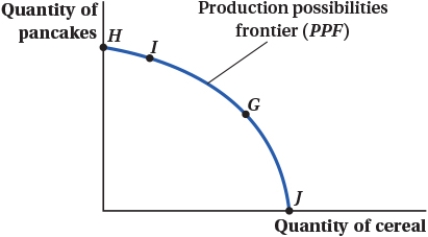
A) The economy is not allocating its inputs efficiently.
B) The economy is not achieving output efficiency because the MRS is less than the MRT.
C) The economy is achieving output efficiency because the MRT equals 1.
D) The economy is not achieving output efficiency because the MRS is greater than the MRT.

A) The economy is not allocating its inputs efficiently.
B) The economy is not achieving output efficiency because the MRS is less than the MRT.
C) The economy is achieving output efficiency because the MRT equals 1.
D) The economy is not achieving output efficiency because the MRS is greater than the MRT.

Unlock Deck
Unlock for access to all 97 flashcards in this deck.
Unlock Deck
k this deck
12
Two legendary rock bands, The Who and Kiss, are scheduling concerts in Detroit this summer. The supply of tickets for The Who concert is fixed at 40,000 and the supply of tickets for the Kiss concert is fixed at 40,000. The demand for tickets for The Who and Kiss are given by the following equations:
Who:
= 100,000 - 1,000PW + 250PK
Kiss:
= 100,000 - 1,000PK + 250PW
Where PW is the price of a ticket for The Who and PK is the price of a ticket for Kiss. In general equilibrium, the price of a ticket for The Who is ____.
A) $100
B) $80
C) $60
D) $40
Who:

= 100,000 - 1,000PW + 250PK
Kiss:

= 100,000 - 1,000PK + 250PW
Where PW is the price of a ticket for The Who and PK is the price of a ticket for Kiss. In general equilibrium, the price of a ticket for The Who is ____.
A) $100
B) $80
C) $60
D) $40

Unlock Deck
Unlock for access to all 97 flashcards in this deck.
Unlock Deck
k this deck
13
Goods X and Y are substitute goods. If the demand for good X increases, the price of good X will _____ and cause a(n) _____ in the demand for good Y. The _____ price for good Y will further _____ the demand for good X, while the _____ price for good X will further _____ the demand for good Y.
A) increase; increase; higher; increase; higher; increase
B) increase; increase; lower; decrease; lower; decrease
C) decrease; decrease; lower; decrease; lower; decrease
D) increase; increase; lower; increase; higher; increase
A) increase; increase; higher; increase; higher; increase
B) increase; increase; lower; decrease; lower; decrease
C) decrease; decrease; lower; decrease; lower; decrease
D) increase; increase; lower; increase; higher; increase

Unlock Deck
Unlock for access to all 97 flashcards in this deck.
Unlock Deck
k this deck
14
Almonds and walnuts are substitutes. Suppose the world demand for walnuts increases.
General equilibrium analysis predicts a ____ effect on the equilibrium price and a ____ effect on the quantity of almonds than partial equilibrium analysis.
A) larger; larger
B) larger; smaller
C) smaller; larger
D) smaller; smaller
General equilibrium analysis predicts a ____ effect on the equilibrium price and a ____ effect on the quantity of almonds than partial equilibrium analysis.
A) larger; larger
B) larger; smaller
C) smaller; larger
D) smaller; smaller

Unlock Deck
Unlock for access to all 97 flashcards in this deck.
Unlock Deck
k this deck
15
(Figure: Cereal and Pancakes IV) What is the name of curve A, and what is its significance? 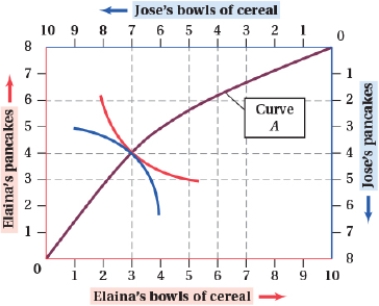
A) contract curve: shows all possible Pareto-efficient allocations of pancakes and cereal between Elaina and Jose
B) contract curve: shows all possible allocations of pancakes and cereal that give Elaina and Jose equal utility
C) output curve: shows all possible combinations of pancakes and cereal that can be produced at a constant per-unit cost
D) isoprofit curve: shows all possible combinations of pancakes and cereal that give the manufacturers equal profit

A) contract curve: shows all possible Pareto-efficient allocations of pancakes and cereal between Elaina and Jose
B) contract curve: shows all possible allocations of pancakes and cereal that give Elaina and Jose equal utility
C) output curve: shows all possible combinations of pancakes and cereal that can be produced at a constant per-unit cost
D) isoprofit curve: shows all possible combinations of pancakes and cereal that give the manufacturers equal profit

Unlock Deck
Unlock for access to all 97 flashcards in this deck.
Unlock Deck
k this deck
16
change their tastes and preferences via their utility function to match the market's marginal rate of substitution.
(Figure: Roses and Guns I) Which of the following output combinations does NOT fall on the production contract curve? I. guns, 20; roses, 2,000
I. guns, 20; roses, 2,000
II) guns, 15; roses, 2,800
III) guns, 90; roses, 750
A) I, II, and III
B) I
C) III
D) I and II
(Figure: Roses and Guns I) Which of the following output combinations does NOT fall on the production contract curve?
 I. guns, 20; roses, 2,000
I. guns, 20; roses, 2,000II) guns, 15; roses, 2,800
III) guns, 90; roses, 750
A) I, II, and III
B) I
C) III
D) I and II

Unlock Deck
Unlock for access to all 97 flashcards in this deck.
Unlock Deck
k this deck
17
Your economics professor decides to cancel one of three scheduled tests because a large number of snow days led to cancellation of classes. Of the 30 students in the class, 29 of them are in favor of this idea and 1 is not in favor. The new number of exams ____ a Pareto improvement because ____.
A) is; almost all of the students are better off
B) is; the total utility increases
C) is not; one student is worse off
D) is not; the total utility decreases
A) is; almost all of the students are better off
B) is; the total utility increases
C) is not; one student is worse off
D) is not; the total utility decreases

Unlock Deck
Unlock for access to all 97 flashcards in this deck.
Unlock Deck
k this deck
18
Two legendary rock bands, The Who and Kiss, are scheduling concerts in Detroit this summer. The supply of tickets for The Who concert is fixed at 40,000 and the supply of tickets for the Kiss concert is fixed at 40,000. The demand for tickets for The Who and Kiss are given by the following equations:
The Who:
= 100,000 - 1,000PW + 250PK
Kiss:
= 100,000 - 1,000PK + 250PW
Where PW is the price of a ticket for The Who and PK is the price of a ticket for Kiss. In general equilibrium, the price of a Kiss ticket is ____.
A) $100
B) $80
C) $60
D) $40
The Who:

= 100,000 - 1,000PW + 250PK
Kiss:

= 100,000 - 1,000PK + 250PW
Where PW is the price of a ticket for The Who and PK is the price of a ticket for Kiss. In general equilibrium, the price of a Kiss ticket is ____.
A) $100
B) $80
C) $60
D) $40

Unlock Deck
Unlock for access to all 97 flashcards in this deck.
Unlock Deck
k this deck
19
The market for soybeans is characterized by  = 18 - Ps and
= 18 - Ps and 
= Ps - 0.5Pc, where Qs is the quantity of soybeans in millions of bushels, Ps is the price per bushel of soybeans, and Pc is the price per bushel of corn. The market for corn is characterized by
= 18 - Pc and
= Pc - 0.5Ps, where Qc is the quantity of corn in millions of bushels. In general equilibrium, the equilibrium quantity of corn is _____ bushels and that of soybeans is _____ bushels.
A) 6 million; 6 million
B) 9 million; 9 million
C) 6.5 million; 6.5 million
D) 16 million; 16 million
 = 18 - Ps and
= 18 - Ps and 
= Ps - 0.5Pc, where Qs is the quantity of soybeans in millions of bushels, Ps is the price per bushel of soybeans, and Pc is the price per bushel of corn. The market for corn is characterized by

= 18 - Pc and

= Pc - 0.5Ps, where Qc is the quantity of corn in millions of bushels. In general equilibrium, the equilibrium quantity of corn is _____ bushels and that of soybeans is _____ bushels.
A) 6 million; 6 million
B) 9 million; 9 million
C) 6.5 million; 6.5 million
D) 16 million; 16 million

Unlock Deck
Unlock for access to all 97 flashcards in this deck.
Unlock Deck
k this deck
20
Consider a society with three people whose utilities are UA = 40, UB = 90, and UC = 60. What is the value of the Rawlsian utility function?
A) 190
B) 50
C) 40
D) 10
A) 190
B) 50
C) 40
D) 10

Unlock Deck
Unlock for access to all 97 flashcards in this deck.
Unlock Deck
k this deck
21
Maximilian rules over a three-person society. The three people are Andre, Bojan, and Soumendra. Andre has a utility level of 60, Bojan's utility level is 80, and Soumendra's utility level is 10. If Maximilian transferred 20 units of utility from Bojan to Soumendra, the value of the Rawlsian social welfare function would be ____.
A) 10
B) 30
C) 60
D) 150
A) 10
B) 30
C) 60
D) 150

Unlock Deck
Unlock for access to all 97 flashcards in this deck.
Unlock Deck
k this deck
22
Almonds and walnuts are substitutes. Suppose the world demand for walnuts increases.
Using partial equilibrium analysis, the equilibrium price of almonds will ____ and quantity of almonds will ____.
A) increase; increase
B) increase; decrease
C) decrease; increase
D) decrease; decrease
Using partial equilibrium analysis, the equilibrium price of almonds will ____ and quantity of almonds will ____.
A) increase; increase
B) increase; decrease
C) decrease; increase
D) decrease; decrease

Unlock Deck
Unlock for access to all 97 flashcards in this deck.
Unlock Deck
k this deck
23
At a birthday party, all the little boys and girls were given various gifts. Some of the boys and girls traded their gifts with one another until everyone was completely happy. This example reflects:
A) input efficiency.
B) output efficiency.
C) altruistic efficiency.
D) exchange efficiency.
A) input efficiency.
B) output efficiency.
C) altruistic efficiency.
D) exchange efficiency.

Unlock Deck
Unlock for access to all 97 flashcards in this deck.
Unlock Deck
k this deck
24
(Figure: Cereal and Pancakes I) The market prices for cereal and pancakes are $2 and $1, respectively. Pareto efficiency requires that the marginal rate of substitution of cereal for pancakes equal _____ for Elaina and _____ for Jose. 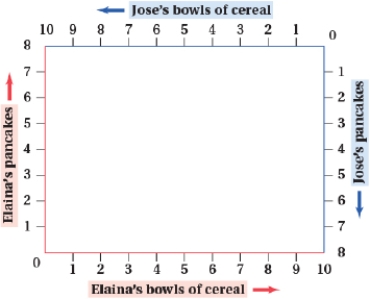
A) 2; 1/2
B) 1/2; 2
C) 2; 2
D) 2; 1

A) 2; 1/2
B) 1/2; 2
C) 2; 2
D) 2; 1

Unlock Deck
Unlock for access to all 97 flashcards in this deck.
Unlock Deck
k this deck
25
(Table: Marginal Products) Which of the following input mixes provides an efficient allocation of labor and capital between the two industries? 
A) I
B) II
C) III
D) IV

A) I
B) II
C) III
D) IV

Unlock Deck
Unlock for access to all 97 flashcards in this deck.
Unlock Deck
k this deck
26
Barbecue sauce and chicken thighs are complement goods. Suppose that the government places a tax on chicken thighs to discourage the consumption of fatty meat. The partial equilibrium effect of the tax on the barbecue sauce market is for price to ____ and quantity to ____.
A) increase; increase
B) increase; decrease
C) decrease; increase
D) decrease; decrease
A) increase; increase
B) increase; decrease
C) decrease; increase
D) decrease; decrease

Unlock Deck
Unlock for access to all 97 flashcards in this deck.
Unlock Deck
k this deck
27
(Figure: Pancakes and Cereal I) Suppose that the economy is operating at point G. In the cereal industry, the marginal product of labor and capital are 10 and 4, respectively. What is the marginal rate of technical substitution of labor for capital in the pancake industry? 
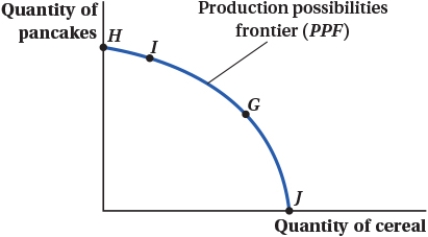
A) 2.5
B) 14
C) 6
D) 40


A) 2.5
B) 14
C) 6
D) 40

Unlock Deck
Unlock for access to all 97 flashcards in this deck.
Unlock Deck
k this deck
28
The First Welfare Theorem states that:
A) perfectly competitive markets in general equilibrium distribute resources Pareto-efficiently.
B) all markets in general equilibrium-from perfectly competitive to monopoly-distribute resources Pareto-efficiently.
C) only monopoly markets in general equilibrium distribute resources Pareto-efficiently.
D) perfectly competitive markets in general equilibrium distribute resources Pareto-efficiently, even in the face of asymmetric information, externalities, and public goods.
A) perfectly competitive markets in general equilibrium distribute resources Pareto-efficiently.
B) all markets in general equilibrium-from perfectly competitive to monopoly-distribute resources Pareto-efficiently.
C) only monopoly markets in general equilibrium distribute resources Pareto-efficiently.
D) perfectly competitive markets in general equilibrium distribute resources Pareto-efficiently, even in the face of asymmetric information, externalities, and public goods.

Unlock Deck
Unlock for access to all 97 flashcards in this deck.
Unlock Deck
k this deck
29
In a country with 100 people, each person has a utility function given by U = LY, where L is hours of leisure per day and Y is daily income. If each person earns $50 per day and enjoys 10 hours of leisure, what is the value of the utilitarian social welfare function for the country as a whole?
A) 500
B) 250
C) 25,000
D) 50,000
A) 500
B) 250
C) 25,000
D) 50,000

Unlock Deck
Unlock for access to all 97 flashcards in this deck.
Unlock Deck
k this deck
30
What are the general equilibrium effects between labor markets and housing markets following an increase in labor demand?
A) As workers' wages increase, more people move into an area, driving up housing prices. The rising housing prices slow the migration of workers to an area.
B) An increase in labor demand will cause a larger wage reduction in areas with an elastic housing supply than with an inelastic housing supply.
C) An increase in labor demand will cause a larger wage increase in areas with an elastic housing supply than with an inelastic housing supply.
D) An increase in labor demand will cause a larger increase in employment in areas with an inelastic housing supply than with an elastic housing supply.
A) As workers' wages increase, more people move into an area, driving up housing prices. The rising housing prices slow the migration of workers to an area.
B) An increase in labor demand will cause a larger wage reduction in areas with an elastic housing supply than with an inelastic housing supply.
C) An increase in labor demand will cause a larger wage increase in areas with an elastic housing supply than with an inelastic housing supply.
D) An increase in labor demand will cause a larger increase in employment in areas with an inelastic housing supply than with an elastic housing supply.

Unlock Deck
Unlock for access to all 97 flashcards in this deck.
Unlock Deck
k this deck
31
(Table: Utility Outcomes) Using the Rawlsian social welfare function, rank the utility outcomes from the most to least desirable. 
A) outcome A, outcome B, outcome C
B) outcome B, outcome C, outcome A
C) outcome A, outcome C, outcome B
D) outcome C, outcome A, outcome B

A) outcome A, outcome B, outcome C
B) outcome B, outcome C, outcome A
C) outcome A, outcome C, outcome B
D) outcome C, outcome A, outcome B

Unlock Deck
Unlock for access to all 97 flashcards in this deck.
Unlock Deck
k this deck
32
(Figure: Cereal and Pancakes V) Suppose that Elaina has 1 pancake and 4 bowls of cereal, which gives her a marginal utility of pancakes of 20 and marginal utility of cereal of 5. Jose has 7 pancakes and 6 bowls of cereal, which gives him a marginal utility of pancakes of 6 and marginal utility of cereal of 18. Which of the following statements is (are) TRUE? 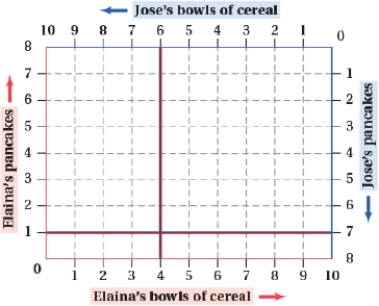
A) The allocation is Pareto-efficient.
B) Elaina and Jose would both be better off if Elaina traded 1 pancake for 1 bowl of Jose's cereal.
C) A Pareto improvement would be for Elaina to give Jose 2 bowls of cereal in exchange for 1 pancake.
D) Elaina and Jose would both be better off if Elaina traded 1/2 pancake for 1 bowl of Jose's cereal.

A) The allocation is Pareto-efficient.
B) Elaina and Jose would both be better off if Elaina traded 1 pancake for 1 bowl of Jose's cereal.
C) A Pareto improvement would be for Elaina to give Jose 2 bowls of cereal in exchange for 1 pancake.
D) Elaina and Jose would both be better off if Elaina traded 1/2 pancake for 1 bowl of Jose's cereal.

Unlock Deck
Unlock for access to all 97 flashcards in this deck.
Unlock Deck
k this deck
33
Pareto efficiency occurs when an economic allocation of goods:
A) makes more winners than losers.
B) equalizes the net gains to all individuals.
C) cannot be changed without at least making one person worse off.
D) enables the winners to compensate the losers for their losses.
A) makes more winners than losers.
B) equalizes the net gains to all individuals.
C) cannot be changed without at least making one person worse off.
D) enables the winners to compensate the losers for their losses.

Unlock Deck
Unlock for access to all 97 flashcards in this deck.
Unlock Deck
k this deck
34
For their birthdays, Vivaan and Saanvi, who are brother and sister, each received 25 iTunes music downloads and 10 movie passes. Vivaan's marginal rate of substitution of music downloads for movie passes is 1/4, while Saanvi's marginal rate of substitution of music downloads for movie passes is 2. For a Pareto improvement over the original allocation, Vivaan gives Saanvi _____ music download(s) for _____ of her movie passes.
A) 1; 3
B) 3; 1
C) 8; 1
D) 1; 4
A) 1; 3
B) 3; 1
C) 8; 1
D) 1; 4

Unlock Deck
Unlock for access to all 97 flashcards in this deck.
Unlock Deck
k this deck
35
(Figure: Crumpets and Tea II) If the economy is at point B, the input mix is: 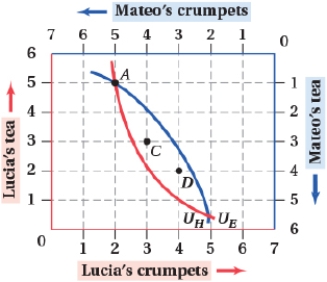
A) not Pareto-efficient; a movement to point C or point D would be a Pareto improvement.
B) Pareto-efficient; a movement to any other point would be Pareto-inefficient.
C) not Pareto-efficient; only a movement to point D would be a Pareto improvement.
D) not Pareto-efficient; a movement to point C or point D would be Pareto-inefficient.

A) not Pareto-efficient; a movement to point C or point D would be a Pareto improvement.
B) Pareto-efficient; a movement to any other point would be Pareto-inefficient.
C) not Pareto-efficient; only a movement to point D would be a Pareto improvement.
D) not Pareto-efficient; a movement to point C or point D would be Pareto-inefficient.

Unlock Deck
Unlock for access to all 97 flashcards in this deck.
Unlock Deck
k this deck
36
The market for coffee is characterized by  and
and 
, where QC is the quantity of coffee in hundreds of pounds, PC is the price per hundred pounds of coffee, and PT is the price per hundred pounds of tea. The market for tea is characterized by
And
, where QT is the quantity of tea in hundreds of pounds.
In general equilibrium, the equilibrium quantity of coffee is ____ pounds.
A) 12,200
B) 12,600
C) 13,000
D) 13,400
 and
and 
, where QC is the quantity of coffee in hundreds of pounds, PC is the price per hundred pounds of coffee, and PT is the price per hundred pounds of tea. The market for tea is characterized by

And

, where QT is the quantity of tea in hundreds of pounds.
In general equilibrium, the equilibrium quantity of coffee is ____ pounds.
A) 12,200
B) 12,600
C) 13,000
D) 13,400

Unlock Deck
Unlock for access to all 97 flashcards in this deck.
Unlock Deck
k this deck
37
Maximilian rules over a three-person society. The three people are Andre, Bojan, and Soumendra. Andre has a utility level of 60, Bojan's utility level is 80, and Soumendra's utility level is 10. Suppose that Maximilian uses a Rawlsian social welfare function to gauge the well-being of society. The value of the Rawlsian social welfare function for this three-person society is ____.
A) 10
B) 50
C) 80
D) 150
A) 10
B) 50
C) 80
D) 150

Unlock Deck
Unlock for access to all 97 flashcards in this deck.
Unlock Deck
k this deck
38
(Figure: Clothing and Food I) Suppose the food industry is using 4 capital inputs and 4 labor inputs, while the clothing industry is using 1 capital input and 4 labor inputs. It would be a Pareto improvement if the _____ industry gave _____ capital input(s) to the _____ industry in exchange for _____ labor input(s). 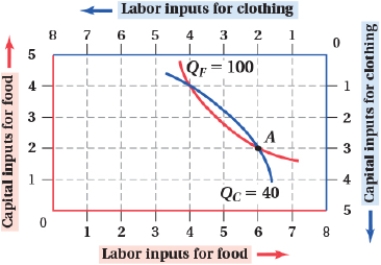
A) food; 1; clothing; 1
B) clothing; 1; food; 1
C) food; 2; clothing; 2
D) clothing; 1; food; 2

A) food; 1; clothing; 1
B) clothing; 1; food; 1
C) food; 2; clothing; 2
D) clothing; 1; food; 2

Unlock Deck
Unlock for access to all 97 flashcards in this deck.
Unlock Deck
k this deck
39
The market for soybeans is characterized by  = 16 - Ps + Pc and
= 16 - Ps + Pc and 
= Ps, where Qs is the quantity of soybeans in millions of bushels, Ps is the price per bushel of soybeans, and Pc is the price per bushel of corn. The market for corn is characterized by
= 40 - Pc + Ps and
= Pc, where
Is the quantity of corn in millions of bushels. Suppose the government eliminates the ethanol mandate, decreasing the demand for corn by 12 million bushels at any given price. The general equilibrium quantity of corn decreases from:
A) 32 million to 24 million bushels.
B) 32 million to 20 million bushels.
C) 20 million to 11 million bushels.
D) 24 million to 14 million bushels.
 = 16 - Ps + Pc and
= 16 - Ps + Pc and 
= Ps, where Qs is the quantity of soybeans in millions of bushels, Ps is the price per bushel of soybeans, and Pc is the price per bushel of corn. The market for corn is characterized by

= 40 - Pc + Ps and

= Pc, where

Is the quantity of corn in millions of bushels. Suppose the government eliminates the ethanol mandate, decreasing the demand for corn by 12 million bushels at any given price. The general equilibrium quantity of corn decreases from:
A) 32 million to 24 million bushels.
B) 32 million to 20 million bushels.
C) 20 million to 11 million bushels.
D) 24 million to 14 million bushels.

Unlock Deck
Unlock for access to all 97 flashcards in this deck.
Unlock Deck
k this deck
40
The market for coffee is characterized by  and
and 
, where QC is the quantity of coffee in hundreds of pounds, PC is the price per hundred pounds of coffee, and PT is the price per hundred pounds of tea. The market for tea is characterized by
And
, where QT is the quantity of tea in hundreds of pounds. Suppose a new medical study touts the benefits of drinking coffee, leading to an increase 30 pounds of coffee at every price. The new equilibrium price of coffee is ____.
A) $85.72
B) $87.25
C) $94.29
D) $99.42
 and
and 
, where QC is the quantity of coffee in hundreds of pounds, PC is the price per hundred pounds of coffee, and PT is the price per hundred pounds of tea. The market for tea is characterized by

And

, where QT is the quantity of tea in hundreds of pounds. Suppose a new medical study touts the benefits of drinking coffee, leading to an increase 30 pounds of coffee at every price. The new equilibrium price of coffee is ____.
A) $85.72
B) $87.25
C) $94.29
D) $99.42

Unlock Deck
Unlock for access to all 97 flashcards in this deck.
Unlock Deck
k this deck
41
The MRTSLK is 5 in the cell phone industry and 8 in the tablet industry. The cell phone industry should use _____ labor and _____ capital, and the tablet industry should use _____ labor and _____ capital.
A) more; more; less; less
B) less; less; more; more
C) more; less; less; more
D) less; more; more; less
A) more; more; less; less
B) less; less; more; more
C) more; less; less; more
D) less; more; more; less

Unlock Deck
Unlock for access to all 97 flashcards in this deck.
Unlock Deck
k this deck
42
(Figure: Pancakes and Cereal I) Suppose the economy is achieving output efficiency at point I, where the marginal rate of transformation (MRT) is 1/4 and the marginal product of labor in the cereal industry is 12. Which of the following statements is TRUE? 
A) The marginal rate of substitution (MRS) between pancakes and cereal is 4.
B) The marginal product of capital in the pancake industry divided by the marginal product of capital in the cereal industry is 4.
C) The marginal product of capital in the pancake industry is 3.
D) MRS/MRT = 1/4.

A) The marginal rate of substitution (MRS) between pancakes and cereal is 4.
B) The marginal product of capital in the pancake industry divided by the marginal product of capital in the cereal industry is 4.
C) The marginal product of capital in the pancake industry is 3.
D) MRS/MRT = 1/4.

Unlock Deck
Unlock for access to all 97 flashcards in this deck.
Unlock Deck
k this deck
43
(Figure: Pancakes and Cereal I) Which of the following statements is (are) TRUE? 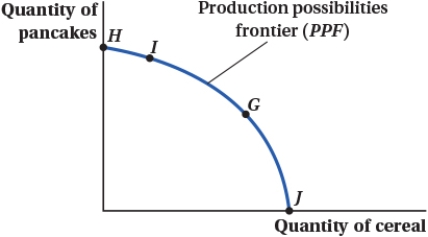 I. Points G, H, I, and J lie on the production contract curve.
I. Points G, H, I, and J lie on the production contract curve.
II) Points H and J represent an inefficient input allocation.
III) At point G, allocating more labor and capital to the cereal industry will increase the output of cereal and pancakes.
A) II
B) I and III
C) I
D) II and III
 I. Points G, H, I, and J lie on the production contract curve.
I. Points G, H, I, and J lie on the production contract curve.II) Points H and J represent an inefficient input allocation.
III) At point G, allocating more labor and capital to the cereal industry will increase the output of cereal and pancakes.
A) II
B) I and III
C) I
D) II and III

Unlock Deck
Unlock for access to all 97 flashcards in this deck.
Unlock Deck
k this deck
44
(Figure: Jets and Drones I) Which of the following statements is TRUE? 
A) At point A, the economy is producing an equal number of jets and drones.
B) At point B, 3 units of capital and 7 units of labor are used to produce drones.
C) At point B, the labor and capital inputs are efficiently allocated across the economy.
D) Fewer jets are being produced at point D than at point A.

A) At point A, the economy is producing an equal number of jets and drones.
B) At point B, 3 units of capital and 7 units of labor are used to produce drones.
C) At point B, the labor and capital inputs are efficiently allocated across the economy.
D) Fewer jets are being produced at point D than at point A.

Unlock Deck
Unlock for access to all 97 flashcards in this deck.
Unlock Deck
k this deck
45
In a small economy that produces smart phones and laptops, the marginal cost of a smart phone is $60 and the marginal cost of a laptop is $150. Assuming the economy is achieving output efficiency, the marginal rate of substitution of smart phones to laptops is ____.
A) 2.5
B) 5
C) 4
D) 60
A) 2.5
B) 5
C) 4
D) 60

Unlock Deck
Unlock for access to all 97 flashcards in this deck.
Unlock Deck
k this deck
46
(Figure: Clothing and Food I) Suppose the food industry is using 3 capital inputs and 5 labor inputs, while the clothing industry is using 2 capital inputs and 3 labor inputs. The economy's output of food is _____ units and the output of clothing is _____ units. 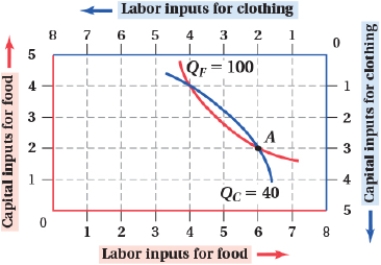
A) greater than 100; less than 40
B) greater than 100; greater than 40
C) less than 100; greater than 40
D) less than 100; less than 40

A) greater than 100; less than 40
B) greater than 100; greater than 40
C) less than 100; greater than 40
D) less than 100; less than 40

Unlock Deck
Unlock for access to all 97 flashcards in this deck.
Unlock Deck
k this deck
47
In the golf club industry, the marginal product of labor and capital are given as  and
and 
) In the tennis racket industry, the marginal product of labor and capital are given as
And
) The price of labor is W and of capital is R. An efficient allocation of labor and capital across the golf club and tennis racket industries requires the following condition:
A)
B)
C)
D)
 and
and 
) In the tennis racket industry, the marginal product of labor and capital are given as

And

) The price of labor is W and of capital is R. An efficient allocation of labor and capital across the golf club and tennis racket industries requires the following condition:
A)

B)

C)

D)


Unlock Deck
Unlock for access to all 97 flashcards in this deck.
Unlock Deck
k this deck
48
(Figure: Crumpets and Tea I) Which of the following allocations represents a Pareto improvement from point A? 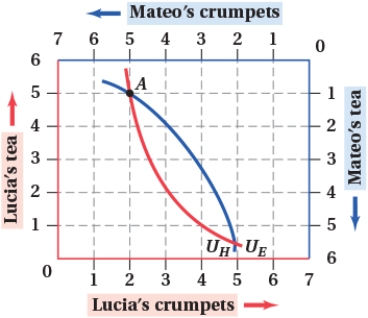 I. Lucia consumes 3 cups of tea and 3 crumpets, and Mateo consumes 3 cups of tea and 4 crumpets.
I. Lucia consumes 3 cups of tea and 3 crumpets, and Mateo consumes 3 cups of tea and 4 crumpets.
II) Lucia consumes 3 cups of tea and 4 crumpets, and Mateo consumes 3 cups of tea and 3 crumpets.
III) Lucia consumes 2 cups of tea and 4 crumpets, and Mateo consumes 4 cups of tea and 3 crumpets.
A) II and III
B) II
C) I and III
D) I, II, and III
 I. Lucia consumes 3 cups of tea and 3 crumpets, and Mateo consumes 3 cups of tea and 4 crumpets.
I. Lucia consumes 3 cups of tea and 3 crumpets, and Mateo consumes 3 cups of tea and 4 crumpets.II) Lucia consumes 3 cups of tea and 4 crumpets, and Mateo consumes 3 cups of tea and 3 crumpets.
III) Lucia consumes 2 cups of tea and 4 crumpets, and Mateo consumes 4 cups of tea and 3 crumpets.
A) II and III
B) II
C) I and III
D) I, II, and III

Unlock Deck
Unlock for access to all 97 flashcards in this deck.
Unlock Deck
k this deck
49
The market for soybeans is characterized by  = 21 - PS and
= 21 - PS and 
= 2PS - PC, where QS is the quantity of soybeans in millions of bushels, PS is the price per bushel of soybeans, and PC is the price per bushel of corn. The market for corn is characterized by
= 21 - PC and
= 2PC - PS, where QC is the quantity of corn in millions of bushels. In general equilibrium, the equilibrium price of corn is ____ and the equilibrium quantity of corn is ____million bushels.
A) $11; 10
B) $10; 10
C) $10.50; 10.5
D) $10.75; 10.25
 = 21 - PS and
= 21 - PS and 
= 2PS - PC, where QS is the quantity of soybeans in millions of bushels, PS is the price per bushel of soybeans, and PC is the price per bushel of corn. The market for corn is characterized by

= 21 - PC and

= 2PC - PS, where QC is the quantity of corn in millions of bushels. In general equilibrium, the equilibrium price of corn is ____ and the equilibrium quantity of corn is ____million bushels.
A) $11; 10
B) $10; 10
C) $10.50; 10.5
D) $10.75; 10.25

Unlock Deck
Unlock for access to all 97 flashcards in this deck.
Unlock Deck
k this deck
50
The market for coffee is characterized by  and
and 
, where QC is the quantity of coffee in hundreds of pounds, PC is the price per hundred pounds of coffee, and PT is the price per hundred pounds of tea. The market for tea is characterized by
And
, where QT is the quantity of tea in hundreds of pounds.
In general equilibrium, the equilibrium quantity of tea is ____ pounds.
A) 12,200
B) 12,600
C) 13,000
D) 13,400
 and
and 
, where QC is the quantity of coffee in hundreds of pounds, PC is the price per hundred pounds of coffee, and PT is the price per hundred pounds of tea. The market for tea is characterized by

And

, where QT is the quantity of tea in hundreds of pounds.
In general equilibrium, the equilibrium quantity of tea is ____ pounds.
A) 12,200
B) 12,600
C) 13,000
D) 13,400

Unlock Deck
Unlock for access to all 97 flashcards in this deck.
Unlock Deck
k this deck
51
In a small economy that produces smart phones and laptops, the marginal cost of a smart phone is $60 and the marginal cost of a laptop is $150. If the economy wanted to produce two more laptops, the production of smart phones would ____ by ____ units.
A) increase; 2.5
B) increase; 5
C) decrease; 5
D) decrease; 2.5
A) increase; 2.5
B) increase; 5
C) decrease; 5
D) decrease; 2.5

Unlock Deck
Unlock for access to all 97 flashcards in this deck.
Unlock Deck
k this deck
52
Suppose that in Blue City each year, 50 rock concerts and 30 opera concerts take place. If the Blue City entertainment czar (someone having great power or authority) decides to schedule 49 rock concerts and 31 opera concerts next year, about 65% of the population will approve, 25% will disapprove, and 10% won't care. This indicates that:
A) output efficiency requires an equal number of rock and opera concerts.
B) it would be a Pareto improvement to schedule one more opera concert at the expense of a rock concert.
C) it would not be a Pareto improvement to schedule one more opera concert at the expense of a rock concert.
D) input efficiency requires an equal number of rock and opera concerts.
A) output efficiency requires an equal number of rock and opera concerts.
B) it would be a Pareto improvement to schedule one more opera concert at the expense of a rock concert.
C) it would not be a Pareto improvement to schedule one more opera concert at the expense of a rock concert.
D) input efficiency requires an equal number of rock and opera concerts.

Unlock Deck
Unlock for access to all 97 flashcards in this deck.
Unlock Deck
k this deck
53
Li's marginal rate of substitution of hamburger for steak is 1/4, and Zhang's marginal rate of substitution of hamburger for steak is 2. The allocation of hamburger and steak ____ Pareto-efficient between Li and Zhang because ____.
A) is; no trade can make both Li and Zhang better off
B) is; Zhang's MRS is exactly 8 times larger than Li's MRS
C) is not; if Li traded some amount of hamburgers to Zhang for some steak, it is possible that each can be better off
D) is not; if Li traded some amount of steak to Zhang for some hamburgers, it is possible that each can be better off
A) is; no trade can make both Li and Zhang better off
B) is; Zhang's MRS is exactly 8 times larger than Li's MRS
C) is not; if Li traded some amount of hamburgers to Zhang for some steak, it is possible that each can be better off
D) is not; if Li traded some amount of steak to Zhang for some hamburgers, it is possible that each can be better off

Unlock Deck
Unlock for access to all 97 flashcards in this deck.
Unlock Deck
k this deck
54
Barbecue sauce and chicken thighs are complement goods. Suppose that the government places a tax on chicken thighs to discourage the consumption of fatty meat. General equilibrium analysis predicts a ____ effect on the equilibrium price and a ____ effect on the quantity of barbecue sauce than partial equilibrium analysis.
A) larger; larger
B) larger; smaller
C) smaller; larger
D) smaller; smaller
A) larger; larger
B) larger; smaller
C) smaller; larger
D) smaller; smaller

Unlock Deck
Unlock for access to all 97 flashcards in this deck.
Unlock Deck
k this deck
55
On the basis of the Carmageddon study, which of the following statements is (are) TRUE about adding another traffic lane to a highway?
I) Partial equilibrium analysis predicts that traffic flow will increase, since drivers will have more usable road space.
II) General equilibrium analysis predicts that traffic flow will remain unchanged, as more businesses and people move to the area.
III) Partial and general equilibrium analysis reach the same conclusion-expanding roadways reduces traffic congestion.
A) I
B) II
C) III
D) I and II
I) Partial equilibrium analysis predicts that traffic flow will increase, since drivers will have more usable road space.
II) General equilibrium analysis predicts that traffic flow will remain unchanged, as more businesses and people move to the area.
III) Partial and general equilibrium analysis reach the same conclusion-expanding roadways reduces traffic congestion.
A) I
B) II
C) III
D) I and II

Unlock Deck
Unlock for access to all 97 flashcards in this deck.
Unlock Deck
k this deck
56
In a small economy that produces smart phones and laptops, the marginal cost of a smart phone is $60 and the marginal cost of a laptop is $150. The marginal rate of transformation from smart phones to laptops is ____.
A) 2.5
B) 5
C) 4
D) 60
A) 2.5
B) 5
C) 4
D) 60

Unlock Deck
Unlock for access to all 97 flashcards in this deck.
Unlock Deck
k this deck
57
The supply of housing in New York City is less elastic than in York, Pennsylvania. As a result, the long-run labor supply curve in New York City is _____ than the long-run labor supply curve in York.
A) more inelastic
B) more elastic
C) more negatively sloped
D) less elastic
A) more inelastic
B) more elastic
C) more negatively sloped
D) less elastic

Unlock Deck
Unlock for access to all 97 flashcards in this deck.
Unlock Deck
k this deck
58
(Figure: Pancakes and Cereal I) Which of the following statements is (are) TRUE at point I? 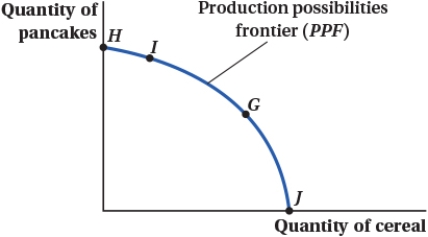 I. The economy is achieving input efficiency.
I. The economy is achieving input efficiency.
II) The economy is achieving exchange efficiency.
III) The economy is achieving output efficiency because the marginal rate of substitution equals the marginal rate of transformation.
A) III
B) I and II
C) I, II, and III
D) II
 I. The economy is achieving input efficiency.
I. The economy is achieving input efficiency.II) The economy is achieving exchange efficiency.
III) The economy is achieving output efficiency because the marginal rate of substitution equals the marginal rate of transformation.
A) III
B) I and II
C) I, II, and III
D) II

Unlock Deck
Unlock for access to all 97 flashcards in this deck.
Unlock Deck
k this deck
59
(Figure: Pancakes and Cereal I) At point G, the marginal rate of transformation from pancakes to cereal is 3. What does this mean?

A) Consumers prefer pancakes to cereal by a 3-to-1 margin.
B) Consumers prefer cereal to pancakes by a 3-to-1 margin.
C) The economy must give up producing 3 pancakes to make another bowl of cereal.
D) The economy must give up producing 1 pancake to make 3 more bowls of cereal.

A) Consumers prefer pancakes to cereal by a 3-to-1 margin.
B) Consumers prefer cereal to pancakes by a 3-to-1 margin.
C) The economy must give up producing 3 pancakes to make another bowl of cereal.
D) The economy must give up producing 1 pancake to make 3 more bowls of cereal.

Unlock Deck
Unlock for access to all 97 flashcards in this deck.
Unlock Deck
k this deck
60
What type of government policy aimed at increasing efficiency would cause the SMALLEST efficiency losses?
A) payroll taxes
B) lump-sum transfers
C) corporate taxes
D) capital gains taxes
A) payroll taxes
B) lump-sum transfers
C) corporate taxes
D) capital gains taxes

Unlock Deck
Unlock for access to all 97 flashcards in this deck.
Unlock Deck
k this deck
61
In a small economy, labor and capital are used to produce food and medicine. In the food industry, the MRTSLK is 8, and in the medicine industry, it is 4. Is the allocation of labor and capital efficient between the two industries? If not, suggest a reallocation of labor and capital that will lead to both industries producing more output.

Unlock Deck
Unlock for access to all 97 flashcards in this deck.
Unlock Deck
k this deck
62
Almonds and walnuts are substitutes. Suppose the world demand for walnuts increases.
a. Using partial equilibrium analysis, predict what happens to the equilibrium price and quantity of almonds.
b. Using general equilibrium analysis, explain how the feedback between the markets affects the almond market. Does general equilibrium analysis predict a larger or smaller effect on the equilibrium price and quantity of almonds than partial equilibrium analysis?
a. Using partial equilibrium analysis, predict what happens to the equilibrium price and quantity of almonds.
b. Using general equilibrium analysis, explain how the feedback between the markets affects the almond market. Does general equilibrium analysis predict a larger or smaller effect on the equilibrium price and quantity of almonds than partial equilibrium analysis?

Unlock Deck
Unlock for access to all 97 flashcards in this deck.
Unlock Deck
k this deck
63
(Figure: Peaches and Cream I) Answer the following questions. 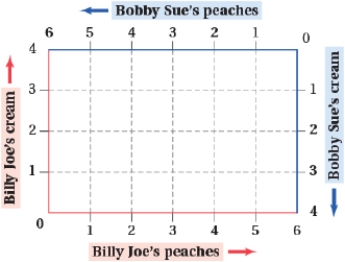
a. On the graph, illustrate a Pareto-efficient allocation of cream and peaches between Billy Joe and Bobby Sue.
b. On the graph, illustrate an inefficient allocation of cream and peaches between Billy Joe and Bobby Sue.
c. Is there a Pareto-efficient allocation that gives Billy Joe most of the cream and peaches?

a. On the graph, illustrate a Pareto-efficient allocation of cream and peaches between Billy Joe and Bobby Sue.
b. On the graph, illustrate an inefficient allocation of cream and peaches between Billy Joe and Bobby Sue.
c. Is there a Pareto-efficient allocation that gives Billy Joe most of the cream and peaches?

Unlock Deck
Unlock for access to all 97 flashcards in this deck.
Unlock Deck
k this deck
64
(Figure: Crumpets and Tea I) Answer the following questions. 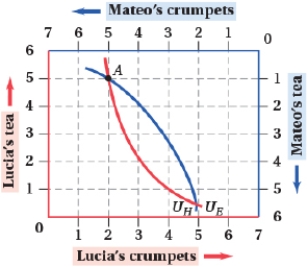
a. At point A, how many crumpets and cups of tea does Eliza have? How many crumpets and cups of tea does Henry have?
b. At point A, give an example of a reallocation of goods that will put Eliza and Henry on higher indifference curves.

a. At point A, how many crumpets and cups of tea does Eliza have? How many crumpets and cups of tea does Henry have?
b. At point A, give an example of a reallocation of goods that will put Eliza and Henry on higher indifference curves.

Unlock Deck
Unlock for access to all 97 flashcards in this deck.
Unlock Deck
k this deck
65
Ying and Fei's marginal rate of substitution of purses for shoes is 2.5. Assuming the allocation of purses and shoes is Pareto efficient, the price ratio of purses to shoes is ____.
A) 2.5
B) 4
C) 2
D) 5
A) 2.5
B) 4
C) 2
D) 5

Unlock Deck
Unlock for access to all 97 flashcards in this deck.
Unlock Deck
k this deck
66
May and Noon both like My Little Pony toys and Matchbox cars. What is the value of each child's marginal rate of substitution at point A? Explain whether that point is or is not a Pareto-efficient outcome. 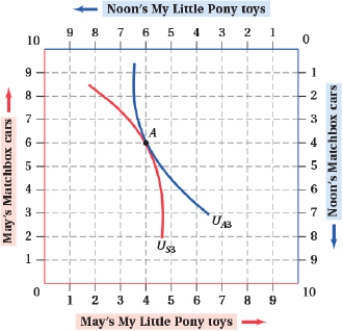


Unlock Deck
Unlock for access to all 97 flashcards in this deck.
Unlock Deck
k this deck
67
(Figure: Cereal and Pancakes I) Which of the following allocations of cereal and pancakes is NOT possible? 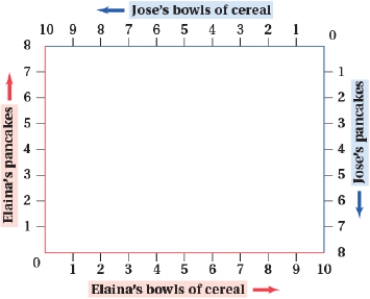
A) Elaina consumes 1 pancake and 4 bowls of cereal, and Jose consumes 7 pancakes and 6 bowls of cereal.
B) Elaina consumes 8 pancakes and 10 bowls of cereal, and Jose consumes no pancakes and no cereal.
C) Elaina consumes 3 pancakes and 6 bowls of cereal, and Jose consumes 6 pancakes and 3 bowls of cereal.
D) Elaina consumes 6 pancakes and 5 bowls of cereal, and Jose consumes 2 pancakes and 5 bowls of cereal.

A) Elaina consumes 1 pancake and 4 bowls of cereal, and Jose consumes 7 pancakes and 6 bowls of cereal.
B) Elaina consumes 8 pancakes and 10 bowls of cereal, and Jose consumes no pancakes and no cereal.
C) Elaina consumes 3 pancakes and 6 bowls of cereal, and Jose consumes 6 pancakes and 3 bowls of cereal.
D) Elaina consumes 6 pancakes and 5 bowls of cereal, and Jose consumes 2 pancakes and 5 bowls of cereal.

Unlock Deck
Unlock for access to all 97 flashcards in this deck.
Unlock Deck
k this deck
68
An economy has a total of 20 units of labor and 10 units of capital to produce food or clothing.
a. Draw the production Edgeworth box.
b. Using isoquants, illustrate a Pareto-efficient allocation of labor and capital between the food and clothing sectors.
c. Using isoquants, illustrate a Pareto-inefficient allocation of labor and capital between the food and clothing sectors.
a. Draw the production Edgeworth box.
b. Using isoquants, illustrate a Pareto-efficient allocation of labor and capital between the food and clothing sectors.
c. Using isoquants, illustrate a Pareto-inefficient allocation of labor and capital between the food and clothing sectors.

Unlock Deck
Unlock for access to all 97 flashcards in this deck.
Unlock Deck
k this deck
69
May and Noon both like My Little Pony toys and Matchbox cars. Explain whether point A is or is not a Pareto efficient outcome. If it is not a Pareto efficient outcome, what combination of products may be a Pareto efficient allocation and why? 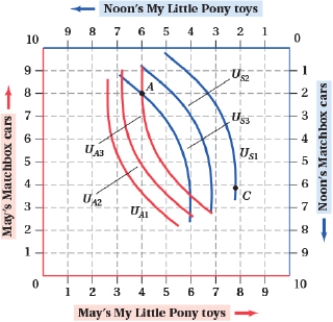


Unlock Deck
Unlock for access to all 97 flashcards in this deck.
Unlock Deck
k this deck
70
The market for coffee is characterized by 
and
, where QC is the quantity in hundreds of pounds and PC is the price per hundred pounds. Also, PT is the price per hundred pounds of tea. The market for tea is characterized by
and
, where QT is the quantity of tea in hundreds of pounds. What is the equilibrium quantity of coffee and tea in general equilibrium?

and

, where QC is the quantity in hundreds of pounds and PC is the price per hundred pounds. Also, PT is the price per hundred pounds of tea. The market for tea is characterized by

and

, where QT is the quantity of tea in hundreds of pounds. What is the equilibrium quantity of coffee and tea in general equilibrium?

Unlock Deck
Unlock for access to all 97 flashcards in this deck.
Unlock Deck
k this deck
71
(Figure: Cereal and Pancakes II) Suppose that Elaina has 6 pancakes and 5 bowls of cereal and Jose has 2 pancakes and 5 bowls of cereal. Which of the following allocations would be a Pareto improvement? Elaina has _____ pancakes and _____ bowls of cereal, and Jose has _____ pancakes and _____ bowls of cereal. 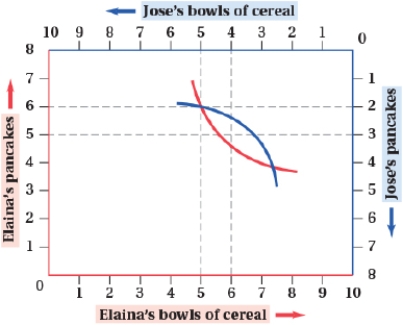
A) 5; 6; 3; 4
B) 5; 5; 3; 5
C) 6; 6; 2; 4
D) 7; 5; 1; 5

A) 5; 6; 3; 4
B) 5; 5; 3; 5
C) 6; 6; 2; 4
D) 7; 5; 1; 5

Unlock Deck
Unlock for access to all 97 flashcards in this deck.
Unlock Deck
k this deck
72
The market for soybeans is characterized by  = 18 - Ps and
= 18 - Ps and 
= Ps - 0.5Pc, where Qs is the quantity of soybeans in millions of bushels, Ps is the price per bushel of soybeans, and Pc is the price per bushel of corn. The market for corn is characterized by
= 18 - Pc and
= Pc - 0.5Ps, where Qc is the quantity of corn in millions of bushels. Suppose the government strengthens the mandate for the use of corn-based ethanol, increasing the demand for corn by 6 million bushels at any given price. In general equilibrium, the equilibrium price of corn is _____, and the equilibrium quantity of soybeans is _____.
A) $14; 4 million bushels
B) $12.80; 5.2 million bushels
C) $13.50; 7 million bushels
D) $10.40; 8.6 million bushels
 = 18 - Ps and
= 18 - Ps and 
= Ps - 0.5Pc, where Qs is the quantity of soybeans in millions of bushels, Ps is the price per bushel of soybeans, and Pc is the price per bushel of corn. The market for corn is characterized by

= 18 - Pc and

= Pc - 0.5Ps, where Qc is the quantity of corn in millions of bushels. Suppose the government strengthens the mandate for the use of corn-based ethanol, increasing the demand for corn by 6 million bushels at any given price. In general equilibrium, the equilibrium price of corn is _____, and the equilibrium quantity of soybeans is _____.
A) $14; 4 million bushels
B) $12.80; 5.2 million bushels
C) $13.50; 7 million bushels
D) $10.40; 8.6 million bushels

Unlock Deck
Unlock for access to all 97 flashcards in this deck.
Unlock Deck
k this deck
73
(Table: Boat and Car Industries) This small economy has a total of 4 units of labor and 4 units of capital to be used between the boat and car industries. 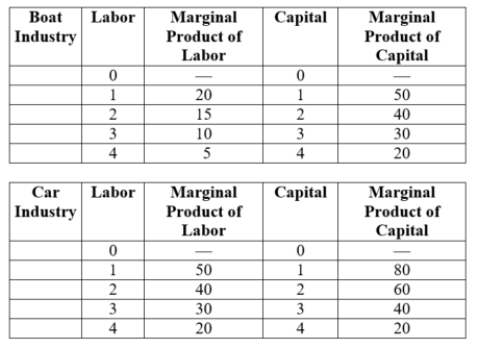
a. Suppose that the boat industry is using 3 units of labor and 2 units of capital, leaving the car industry with 1 unit of labor and 2 units of capital. What is the MRTSLK in the boat industry? In the car industry?
b. If the wage rate (W) is $100 and the rental rate of capital (R) is $200, what is a Pareto-efficient allocation of labor and capital between the two industries?

a. Suppose that the boat industry is using 3 units of labor and 2 units of capital, leaving the car industry with 1 unit of labor and 2 units of capital. What is the MRTSLK in the boat industry? In the car industry?
b. If the wage rate (W) is $100 and the rental rate of capital (R) is $200, what is a Pareto-efficient allocation of labor and capital between the two industries?

Unlock Deck
Unlock for access to all 97 flashcards in this deck.
Unlock Deck
k this deck
74
The market for soybeans is characterized by  = 21 - PS and
= 21 - PS and 
= 2PS - PC, where QS is the quantity of soybeans in millions of bushels, PS is the price per bushel of soybeans, and PC is the price per bushel of corn. The market for corn is characterized by
= 21 - PC and
= 2PC - PS, where QC is the quantity of corn in millions of bushels. In general equilibrium, the equilibrium price of soybeans is ____ and the equilibrium quantity of soybeans is ____million bushels.
A) $11; 10
B) $10; 10
C) $10.50; 10.5
D) $10.75; 10.25
 = 21 - PS and
= 21 - PS and 
= 2PS - PC, where QS is the quantity of soybeans in millions of bushels, PS is the price per bushel of soybeans, and PC is the price per bushel of corn. The market for corn is characterized by

= 21 - PC and

= 2PC - PS, where QC is the quantity of corn in millions of bushels. In general equilibrium, the equilibrium price of soybeans is ____ and the equilibrium quantity of soybeans is ____million bushels.
A) $11; 10
B) $10; 10
C) $10.50; 10.5
D) $10.75; 10.25

Unlock Deck
Unlock for access to all 97 flashcards in this deck.
Unlock Deck
k this deck
75
The Second Welfare Theorem states that:
A) perfectly competitive markets, if Pareto-efficient, are equitable.
B) Pareto efficiency implies that input allocations are socially desirable.
C) Pareto efficiency cannot occur if resources are not equitably allocated.
D) any Pareto-efficient allocation can be achieved in a perfectly competitive market by adjusting the initial allocations of goods.
A) perfectly competitive markets, if Pareto-efficient, are equitable.
B) Pareto efficiency implies that input allocations are socially desirable.
C) Pareto efficiency cannot occur if resources are not equitably allocated.
D) any Pareto-efficient allocation can be achieved in a perfectly competitive market by adjusting the initial allocations of goods.

Unlock Deck
Unlock for access to all 97 flashcards in this deck.
Unlock Deck
k this deck
76
Higher education and textbooks are complementary goods. The government decides to subsidize public college education. Compare the partial and general equilibrium effects of this subsidy on the market for public education.

Unlock Deck
Unlock for access to all 97 flashcards in this deck.
Unlock Deck
k this deck
77
What is the First Welfare Theorem? What conditions are required for it to hold true?

Unlock Deck
Unlock for access to all 97 flashcards in this deck.
Unlock Deck
k this deck
78
Which of the following situations is an example of general equilibrium analysis?
A) An excise tax is placed on cigarettes reducing the supply of cigarettes and leading to higher cigarette prices.
B) A severe frost destroys a significant portion of the coffee crop, leading to higher coffee prices. The higher coffee prices increase the demand for tea, resulting in higher tea prices. The higher tea prices, in turn, cause the demand for coffee to rise even more, further increasing the price of coffee.
C) A decrease in the demand for peanuts causes both the equilibrium price and quantity of peanuts to decrease. As a result, peanut farmers reduce their peanut output and supply decreases.
D) As fuel costs rise, airlines' costs of production rise. Higher production costs drive profits down, leading to higher air fares and fewer flights.
A) An excise tax is placed on cigarettes reducing the supply of cigarettes and leading to higher cigarette prices.
B) A severe frost destroys a significant portion of the coffee crop, leading to higher coffee prices. The higher coffee prices increase the demand for tea, resulting in higher tea prices. The higher tea prices, in turn, cause the demand for coffee to rise even more, further increasing the price of coffee.
C) A decrease in the demand for peanuts causes both the equilibrium price and quantity of peanuts to decrease. As a result, peanut farmers reduce their peanut output and supply decreases.
D) As fuel costs rise, airlines' costs of production rise. Higher production costs drive profits down, leading to higher air fares and fewer flights.

Unlock Deck
Unlock for access to all 97 flashcards in this deck.
Unlock Deck
k this deck
79
Anika, Pari, Amy, and Anna are college roommates living off campus. All four of them have a utility function given by U = Y0.5, where Y is income per day. Suppose that Anika earns $8 per day, Pari earns $81, Amy earns $49, and Anna earns $16. What happens to the value of the Rawlsian social welfare function if $17 is taken from Pari and given to Anika?

Unlock Deck
Unlock for access to all 97 flashcards in this deck.
Unlock Deck
k this deck
80
The market for wheat is characterized by  = 21 - 2Pw + Pc and
= 21 - 2Pw + Pc and 
= Pw, where Qw is the quantity of wheat in millions of bushels, Pw is the price per bushel of wheat, and Pc is the price per bushel of corn. The market for corn is characterized by
= 21 - 2Pc + Pw and
= Pc, where
Is the quantity of corn in millions of bushels. In general equilibrium, what are the prices of wheat and corn?
A) Pw = $12; Pc = $12
B) Pw = $6.50; Pc = $9.50
C) Pw = $9.50; Pc = $6.50
D) Pw = $10.50; Pc = $10.50
 = 21 - 2Pw + Pc and
= 21 - 2Pw + Pc and 
= Pw, where Qw is the quantity of wheat in millions of bushels, Pw is the price per bushel of wheat, and Pc is the price per bushel of corn. The market for corn is characterized by

= 21 - 2Pc + Pw and

= Pc, where

Is the quantity of corn in millions of bushels. In general equilibrium, what are the prices of wheat and corn?
A) Pw = $12; Pc = $12
B) Pw = $6.50; Pc = $9.50
C) Pw = $9.50; Pc = $6.50
D) Pw = $10.50; Pc = $10.50

Unlock Deck
Unlock for access to all 97 flashcards in this deck.
Unlock Deck
k this deck



